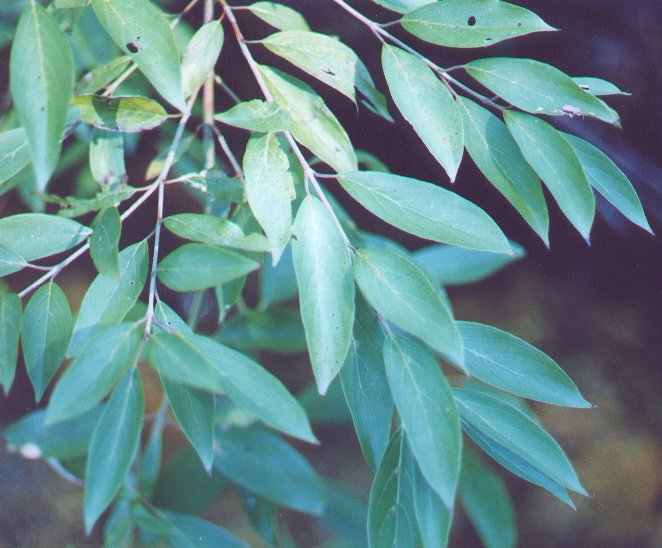Cornus amomum Mill.
Swamp Dogwood

Native
CC = 5
CW = -3
MOC = 86
© DETenaglia
Cornus amomum Mill.Swamp Dogwood | |
 |
Native CC = 5 CW = -3 MOC = 86 |
© DETenaglia |
|
Family - Cornaceae Habit - Shrubs, 1-4 m tall, usually solitary. Stems - Twigs reddish brown to purplish brown, densely tomentose-hairy when young, becoming glabrous or nearly so with age, the pith brown. Bark smooth or with shallow fissures, not becoming corky, reddish brown, usually with small, slightly raised to somewhat warty, lighter dots.
Leaves - Opposite, simple, petiolate, usually evenly dispersed along the branches, the petiole 0.5-1.5 cm long, tomentose. Leaf blades 4-9 cm long, 1-4 cm wide, narrowly lanceolate or narrowly elliptic to ovate, angled or tapered at the base, angled or more commonly tapered to a bluntly or sharply pointed tip, the surfaces sparsely to moderately pubescent with appressed, straight, T-shaped hairs and somewhat spreading, V-shaped or Y-shaped hairs, the upper surface dark green, the lower surface whitened, the lateral veins 4-6 pairs, these relatively evenly spaced, abaxially expressed.
Inflorescence - Flat-topped panicles (cymes) at branch tips, broader than tall. Bracts absent or rarely a few at the branch points and these minute and scalelike. Flower stalks 2-3 mm long, hairy, becoming reddish brown as the fruits mature.
Flowers - Sepals 4, 0.6-1.2 mm long. Petals 4, 3.5-5.0 mm long, narrowly oblong-lanceolate, white to cream-colored. Style 2-4 mm long, relatively stout, broadened toward the tip. Stamens 4. Five parted flowers occasionally seen.
Fruits - Globose drupe 5-8 mm in diameter, dark blue, sometimes with white blotches. Stone with 6-9 sharply angled longitudinal ridges.
Flowering - May - July. Habitat - Streambanks, pond margins, fens, bottomland forests, wet prairies, pastures, roadsides. Origin - Native to the U.S. Lookalikes - Cornus drummondii, Cornus foemina. Other info. - This species is found scattered throughout Missouri, almost always in wet places. Outside of Missouri its range extends into the upper Midwest, New England, and Canada. Though similar in appearance to other dogwood species, it can be distinguished by its narrow leaves and flat-topped inflorescences which are broader than tall. The young twigs are also densely hairy. The image above doesn't do the fruits justice; they are brilliant blue. Photographs taken near Hercules Glade, Mark Twain National Forest, Taney County, MO., 9-10-99, and in Ripley County, MO., 6-5-04 (DETenaglia); also in Kaintuck Hollow Natural Area, Phelps County, MO, 6-9-2018, and Victoria Glade, Jefferson County, MO, 8-19-2020 (SRTurner). |